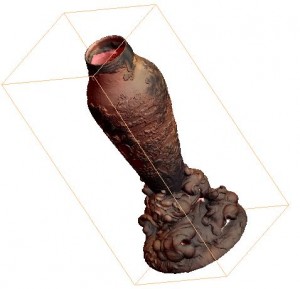3D scanning in the project is carried out by German company Steinbichler. The scanning is carried out on site, with laser scanners, and with absolutely no effect to the artworks. The applications of 3D laser scanning are manifold in the automotive and aerospace industry, but these techniques are more and more often applied in museums as well. In addition to producing virtual models of actual objects, the very precise process of 3D scanning can be applied in restorations as well as condition checking. In general, these system can provide digital data with very high precision.
The process is very easy: a laser scanner takes precise measurements of the objects from all angles, and this data is then digitally combined with photographs also taken from many angles. Some scanner are capable of retrieving precise structural information (with the laser scanner) along with information on the surface of the object. There are difficulties, as well: transparent objects, such as glass, are very hard to scan. The Partage Plus project will analyze these methods, find ways to ovecome the difficulties, and also examine the potential application of 3D scanning.
One successful application of 3D scanning – and 3D printing – was the restoration of Rodin’s Thinker of the Singer Laren Museum, which was cut up and damaged in a theft in 2007. The restoration was completed in 2011 – you can read about it here, or learn even more on this website. The Steinbichler website also has other application stories. A recent article in The Telegraph also reports on the potential applications of 3D scanning in the artworld.



